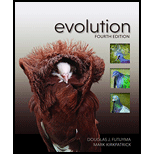
Concept explainers
To explain: Whether clades with few living species may be very young.
Introduction: A group of organisms that have been originated and evolved from one common ancestor is called a clade. The variation occurred due to the evolution of a common ancestor to adapt and diversify into one or more species and subgroups. Since the origin is same, clade is said to be monophyletic. The construction of a phylogenetic tree helps to observe clades.
To explain: Alternate hypothesis to define different clades.
Introduction: A group of organisms that have been originated and evolved from one common ancestor is called a clade. The variation occurred due to the evolution of a common ancestor to adapt and diversify into one or more species and subgroups. Since the origin is same, clade is said to be monophyletic. The construction of a phylogenetic tree helps to observe clades.
To explain: Evidence of the hypothesis used to define clades.
Introduction: A group of organisms that have been originated and evolved from one common ancestor is called a clade. The variation occurred due to the evolution of a common ancestor to adapt and diversify into one or more species and subgroups. Since the origin is same, clade is said to be monophyletic. The construction of a phylogenetic tree helps to observe clades.
To explain: The components constituting the evidence used to define different clades.
Introduction: A group of organisms that have been originated and evolved from one common ancestor is called a clade. The variation occurred due to the evolution of a common ancestor to adapt and diversify into one or more species and subgroups. Since the origin is same, clade is said to be monophyletic. The construction of a phylogenetic tree helps to observe clades.
Want to see the full answer?
Check out a sample textbook solution
Chapter 19 Solutions
Evolution, Fourth Edition (looseleaf)
- What is behavioral adaptarrow_forward22. Which of the following mutant proteins is expected to have a dominant negative effect when over- expressed in normal cells? a. mutant PI3-kinase that lacks the SH2 domain but retains the kinase function b. mutant Grb2 protein that cannot bind to RTK c. mutant RTK that lacks the extracellular domain d. mutant PDK that has the PH domain but lost the kinase function e. all of the abovearrow_forwardWhat is the label ?arrow_forward
- Can you described the image? Can you explain the question as well their answer and how to get to an answer to an problem like this?arrow_forwardglg 112 mid unit assignment Identifying melting processesarrow_forwardGive only the mode of inheritance consistent with all three pedigrees and only two reasons that support this, nothing more, (it shouldn't take too long)arrow_forward
- Oarrow_forwardDescribe the principle of homeostasis.arrow_forwardExplain how the hormones of the glands listed below travel around the body to target organs and tissues : Pituitary gland Hypothalamus Thyroid Parathyroid Adrenal Pineal Pancreas(islets of langerhans) Gonads (testes and ovaries) Placentaarrow_forward
 Biology: The Dynamic Science (MindTap Course List)BiologyISBN:9781305389892Author:Peter J. Russell, Paul E. Hertz, Beverly McMillanPublisher:Cengage Learning
Biology: The Dynamic Science (MindTap Course List)BiologyISBN:9781305389892Author:Peter J. Russell, Paul E. Hertz, Beverly McMillanPublisher:Cengage Learning Concepts of BiologyBiologyISBN:9781938168116Author:Samantha Fowler, Rebecca Roush, James WisePublisher:OpenStax College
Concepts of BiologyBiologyISBN:9781938168116Author:Samantha Fowler, Rebecca Roush, James WisePublisher:OpenStax College Biology (MindTap Course List)BiologyISBN:9781337392938Author:Eldra Solomon, Charles Martin, Diana W. Martin, Linda R. BergPublisher:Cengage Learning
Biology (MindTap Course List)BiologyISBN:9781337392938Author:Eldra Solomon, Charles Martin, Diana W. Martin, Linda R. BergPublisher:Cengage Learning
 Human Heredity: Principles and Issues (MindTap Co...BiologyISBN:9781305251052Author:Michael CummingsPublisher:Cengage Learning
Human Heredity: Principles and Issues (MindTap Co...BiologyISBN:9781305251052Author:Michael CummingsPublisher:Cengage Learning Biology Today and Tomorrow without Physiology (Mi...BiologyISBN:9781305117396Author:Cecie Starr, Christine Evers, Lisa StarrPublisher:Cengage Learning
Biology Today and Tomorrow without Physiology (Mi...BiologyISBN:9781305117396Author:Cecie Starr, Christine Evers, Lisa StarrPublisher:Cengage Learning





